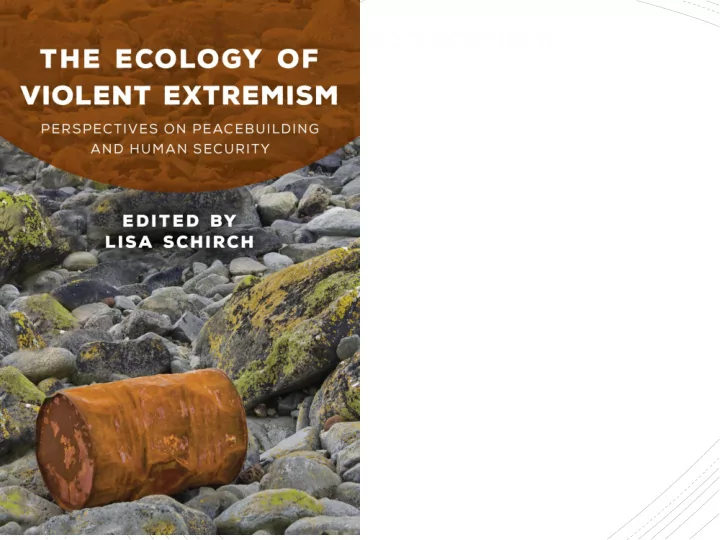

The Ecology of Violent Extremism
Compare and contrast different definitions of violent extremism Identify 25 factors that relate to violent extremism Identify three categories of interventions to violent extremism Course Identify the dangers, risks and unintended Objectives impacts of interventions to stop violent extremism Practice using planning tools to identify complementary and coordinated programs to respond to violent extremism
• Violent extremism (VE) takes place within social, political, economic, religious, cultural, and environmental systems. • Violent extremism results from a variety of diverse and often interrelated causes, including recruitment, individual motivations, The VE System factors in the national and global context, and impacts from VE interventions. • There are no quick fixes for violent extremism. There are a variety of different interventions that aim to prevent or stop VE.
CIVILIANS An attack on civilians and civilian property What is a civilian? Defining Terrorism #1
State vs Non-State Actors Legal authority to use violence? No intention to kill civilians – collateral damage State Terrorism Defining State-sponsored Terrorism Terrorism #2
Deaths Deaths Deaths Deaths Deaths from from from heart from traffic from opioid Terrorism violent disease in accidents overdose in in 2016 conflict in 2015 in 2015 US in 2016 2016 25,000+ 157,000+ 15 million 1.3 million 42,000 Terrorism is not scary because it kills more people than other social problems.
Annual Average Conserv Approxi death toll annual ative mate from death toll estimate death toll terrorism from of from war The death toll from in 2000 terrorism average on terror since annual from terrorism is equal 2013 death toll 2001- to, or possibly a 2016 from war on terror third less than the from death toll from 2001- counterterrorism. 2016 Less than 25,000- 24,666 370,000 5000 33,000 to 1 million
Cost to Global US Amount plan and impact of spending that carry out terrorism on would a terror between countert have attack in 2001- errorism been Europe 2016 between saved if The economic 2000- peacebui 2017 lding impact of terrorism funded is less than the for 10 economic impact of most at- risk counterterrorism countries $10 $724 Between $552 thousand billion billion $1.7 and $5.6 trillion
The increase in terrorism and counterterrorism correlates with a decrease in political rights and civic freedoms
Violence is a necessary strategy Tactical superiority Redemptive Civilian Targets Purification Characteristics of Responsibility Authoritarian Narrative Violent Intolerant Extremism Patriarchal Authoritarian Ideological Goals Ideological identity Response to grievance
Ku Klux Klan (KKK)
Orlando Shooter/ISIS
Kahanists
Kenyan Human Rights Organization
Black Lives Matter
Movement for the Emancipation of the Niger Delta ( MEND )
Bangladesh Political Violence
OREGON ANTI-GOVERNMENT MILITIA STANDOFF
Ideological Superiority Belief in Brutal Violent Goals Narrative Violence Extremists ? Intolerant of Against Diversity Civilians White nationalists X X X Yes X X X Yes Orlando Shooter/ISIS Kahanists X X X Yes X No Kenyan Human Rights Organizations X No Black Lives Matter US School Shooters X X No
Individual Identity Context VE Factor Description Theories of Change Adventure, Significance Desire for exotic travel or new Opportunities for travel; creation of new “hero” groups experiences and sense of glory Social Isolation Sense of isolation and desire for group Civic engagement, sports, arts, and other membership groups to provide belonging Transition and Migration Uprooted community with unsettled or Psycho-social support services; unpredictable future community organizing Perception of attacks on one’s religion or Fear Affirmation for identity groups; human identity rights education; dialogue Humiliation Perception of disrespect & desire for Symbolic gestures of respect; principle power for revenge and to gain respect of dignity and human rights in all interventions Mental Health, Hormones Biological and physical aspects that Community support to channel bio- contribute to VE beliefs physical aspects; Psycho-social support services and trauma recovery programs Sex Sexual rewards for participating in Gender awareness training; organized terrorism sports activities Gender Roles Social norms for men and women Gender awareness training; inclusion of encourage participation in VE women in VE interventions
Community Grievance Context VE Factor Description Theories of Change General VE Public grievances against the state Counterterrorism/CVE counter-narratives to alter perceptions grievances Nonviolent civil resistance to push for changes to address grievances Improve state-society relationship with peacebuilding efforts Political Civil War or Insurgency with armed groups Political peace process with DDR Grievances Perception that state power is elite-captured Democratic reforms and participatory governance Perception that Western countries dominate Reform global political institutions to increase representation global politics and empowerment of non-Western states Graft, bribery and corruption to favor elites Reform of national governance to increase transparency State military or police repression of Security sector reform to increase adherence to human rights population and/or inability to protect people and international humanitarian law, and civilian oversight and from non-state group threats human security Economic Relative deprivation between groups, State grants to community for community-led sustainable Grievances perceived inequality with structural economic development privileges Money or other financial incentives Promotion of private sector growth and job creation Perception that trade system favors wealthy Economic and trade reforms to support fair trade nations Social Weak relational ties between social groups Inter-group dialogue, programs to enhance social well-being grievances and strong relational ties within Perception of social exclusion Social cohesion programs
The overwhelming majority of terrorism occurs in countries that fall into two categories; • countries involved in an armed conflict, or Global Terrorism • countries with high levels of political terror. Index 2017
“Higher levels of political terror, lower respect for human rights, the existence of policies targeting religious freedoms, group grievances, political instability and lower respect for the UN or the EU all correlate with higher levels of terrorism.” -Global Terrorism Index
Recommend
More recommend